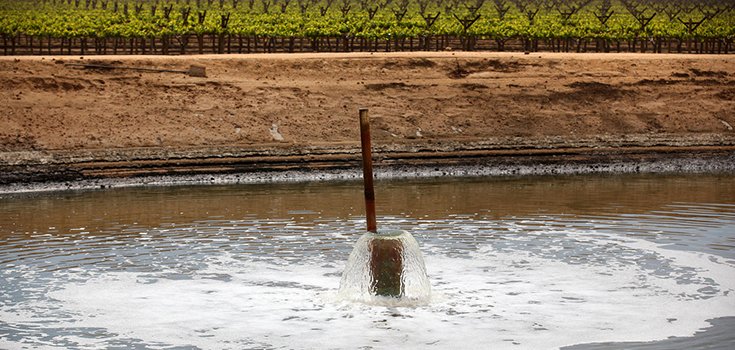California Crops Watered with Questionable Oil Field Wastewater

California is thirsty and crops are in desperate need of water after the latest long-lasting drought, but the method of providing water to millions of rows of crops in the sunny state is getting some funny looks. Oil giant Chevron is selling “recycled” oil field wastewater to irrigate about 10% of the farmland of Kern County, California.
Every day, Chevron recycles and sells 21 million gallons of the treated wastewater to farmers who are using it on about 45,000 acres of crops.
Though local and state authorities think it’s a grand idea to continue this 2-decade old program to deal with California’s lingering drought crisis, environmentalists are understandably concerned. More companies are now applying for permits to sell oilfield wastewater back to California farmers. With such an eager market, many people are worried that the safety measures are insufficient to ensure that toxic chemicals from oil production are not being dumped on our farmland.
In recent tests of “recycled” water being used to irrigate crops, it was found that the water contained traces of acetone and methylene chloride after treatment. Other tests show what can be found in untreated, or improperly treated oilfield water:
- Oil, 240,000-480,000 parts per million
- Acetone, 440-530 parts per billion
- Methylene chloride, 82-89 parts per billion

The samples were taken from the Poso Creek Oil Field, which is not owned by Chevron. But with multiple companies clamoring to sell back their wastewater, who will ensure that it is not contaminated with similar chemicals?
To date, government authorities require hardly any testing of recycled irrigation water, and usually check only for naturally occurring toxins like salts or arsenic. The decades-old standards don’t include oil production chemicals in their screenings.
This means that California oranges, aside from being sprayed with Roundup chemicals, can now be further contaminated with petrochemicals from the oil field wastewater used to irrigate the fields. Only state and local authorities currently have any say about whether to keep the oil companies accountable. This means there’s no way to ensure that the wastewater sold back to farmers is truly devoid of these contaminants.
Related Read: Could This New Method of Water Retention Save California from the Drought?
The wastewater recycling program is regulated by the Central Valley water authority. Just last month, the water authority notified all oil producers of new, broader testing requirements. The companies must begin checking for chemicals covered under California’s new fracking disclosure regulations.
This law was approved last year and requires disclosure of which chemicals the companies use in oil-extraction processes. There’s the usual problem, though, with ‘self-regulation’ by corporations and no independent, third-party testing.
Clay Rodgers, assistant executive officer of the Central Valley Water Quality Control Board, said:
“We need to make sure we fully understand what goes into the wastewater.”
This is going to be difficult, though, if the same companies wanting to sell recycled water to farmers are the ones doing the testing for what is in the water. It’s just like Monsanto doing its own testing on glyphosate and reporting the results to government agencies. The public will have no transparency about what is in the water used on their food.
An example of this contamination was apparent in recycled wastewater sold by Chevron to the Cawelo Water District. Methylene chloride was found to be 56 parts per billion in one sample, although Chevron claims it doesn’t use methylene chloride in its oil extraction processes.
This level of methylene chloride is nearly four times the amount registered at the oil-contaminated river at Mayflower, Arkansas, scene of the 2013 ExxonMobil tar sands pipeline spill. That spill was declared a federal disaster, and caused evacuations. It resulted in a $2.7-million fine for ExxonMobil.
Are California’s crops truly safe with recycled oilfield wastewater? You be the judge.
Sources:
LA Times (Featured image credit: Brian van der Brug / Los Angeles Times)
